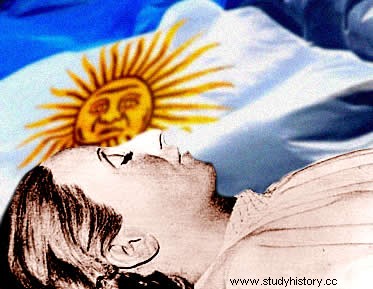
By Rainer Sousa
The process of urbanization and industrialization in Latin America was an economic experience that determined profound changes in several countries. The strength of rural elites ended up losing its dominance to the rise of new leaders who reached the great mass of urban workers and liberal professionals. In this context, we have the development of populism as a historical phenomenon that marked politics in the Americas until the first half of the 20th century.
In Argentina, the populist phenomenon reached its peak with the government of Juan Domingo Perón. During the time he was at the head of the Argentine nation, the charismatic leader was helped by the strong performance of his wife, Eva Duarte Perón, who relied on her beauty and experience as a radio soap opera actress to help the most needy with tireless welfare actions. . As time went on, the first lady's charisma seemed to surpass that of the head of state himself.
Afflicted by a violent cancer, Evita Perón died on July 26, 1952. The sad news not only reached the various citizens who idolized her figure, but also marked the agony of the Argentine populism. After her death, her body had been subjected to a delicate embalming process and kept on the second floor of the General Confederation of Labor. In the meantime, Perón's intention was to build a large mausoleum for the legendary “mother of the shirtless.”
However, in 1955, a military uprising ended up promoting the fall of Perón and the discovery of the chemically preserved body. After confirming that it was Evita, the coup plotters feared that that lifeless body would become a sacred icon for the various followers of Peronism. Some thought it best to disintegrate it permanently. Finally, Pedro Aramburu, the new president sworn in, delegated to Colonel Carlos Koeing the mission of secretly burying her.
Instead of fulfilling his mission, the bizarre military man hid the body in different places until he installed it in his office. Before long, dire rumors spread that Koeing was engaging in strange sexual behavior in the presence of Evita's corpse. Before long, the officer had been removed and a plan for the removal of the body had been put in place. The so-called “Operation Transfer” buried the deceased in Italy under the pseudonym Maria Maggi de Magistris.
During the 1960s, the Argentine population was suspicious of the official version that Evita's body had been destroyed. In 1970, President Aramburu was kidnapped by young Peronists who demanded information about the corpse of the idolized “Madre Mía”. The president refused to reveal his whereabouts and was eventually executed by the group. In 1971, the Argentine government decided to hand over the body to Juan Perón, who was exiled in Spain.
At that time, new rumors said that José López Rega, Juan Perón's assistant, performed witchcraft rituals that intended to transfer Evita's soul to Isabel Martínez, the former president's third wife. . In 1973, with the return of democracy, Perón won the elections and left Evita's body in Spanish lands. Dissatisfied, the Peronists carried out the kidnapping of the body of former president Aramburu and demanded that the idolized figure return to his native country.
The following year, Juan Perón died and the Argentine government was taken over by Isabel Martínez, who was on the ticket as vice president. She herself tried to place Evita next to Juan Perón, in the presidential residence of Olivos. In 1976, a new military coup took over Argentina and changed Evita's fate. In order to put an end to the rumours, the new regime handed over the body to Evita Perón's sisters. To this day, Evita's body is deposited in the Recoleta Cemetery, the target of several pilgrimages.
Contemporary Age
